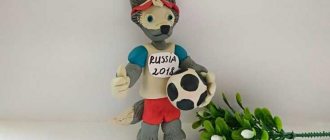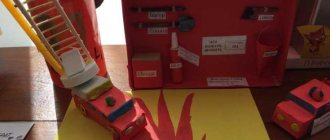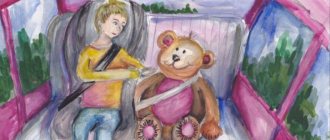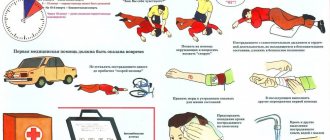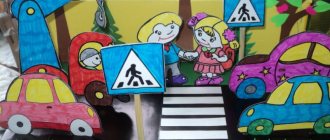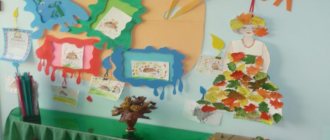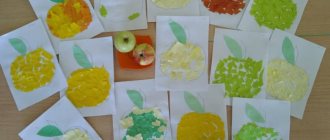If you don’t know what craft to make for school on the topic of fire safety, then read the article and look at the photo.
It is very useful for a child to know that fire is not a toy. Thanks to classes in kindergarten or school, children clearly learn how to behave in the event of a fire or how to prevent it. Teachers or educators, in order to reinforce the material, assign homework - to do work on the topic of fire safety. Some parents can't figure out what to do.
Don't worry - the task is only difficult at first glance. In fact, crafts can be made from various materials, and they come in varying degrees of complexity. Even five-year-old kids can do some of them under your guidance.
Requirements for design and size
Shields are made hinged or installed on racks.
A hinged fire shield is a plywood (wooden) or metal sheet to which hooks for equipment are attached. You can also find a more rational model, in which only a durable metal frame is made. There are fasteners attached to it. If the frame is painted red and hung on a white wall, it will satisfy all design requirements. Closed type panels are made in the form of boxes with lattice or glass doors. This makes it possible to see the contents, but protects against unwanted penetration inside. The depth of the box should be such that it does not block the passage, and at the same time accommodate all the necessary tools.
The edging of the fire shield has a width of 3...10 cm and is also painted red or in red and white stripes running at an angle of 45°...60°. The field on which the tool is attached is white. On white, red and black details are visible from afar.
According to the requirements, in addition to tools for fighting a fire, telephone numbers are placed on the shield by which you can call the Ministry of Emergency Situations or contact details of the nearest fire station. There is also an inventory of tools.
The height and width of the fire shield does not exceed 1.5 m. Each item is placed on the shield separately, so the dimensions may vary depending on the configuration.
Tools must not be screwed or nailed tightly. They are hung on hooks so that they can be easily removed. You can do this yourself by purchasing equipment and a shield separately. You can also buy all the necessary fire tools in a kit.
Introduction to the Threat Model
Okay, let's move on to the contents of the document.
I think about the title page, the list of abbreviations, terms and definitions, everything is clear. Although, perhaps, it’s worth taking a closer look at... suddenly the title page.
In the template, it is signed by the manager of the owner of the information system. It's not just like that.
Decree of the Government of the Russian Federation of May 11, 2022. No. 555:
4. The terms of reference for the creation of the system and the model of threats to information security are approved by an official of the executive authority who is entrusted with the appropriate powers.
Naturally, if the information system is not state-owned and the system operator is not an executive authority, then anyone can sign the threat model. It’s just that we have encountered more than once when, when the above conditions were met (state information system of an executive authority), the customer asked us to change the title page so that there were signatures only of representatives of the licensee company (that is, ours). We had to explain why FSTEC would return such a threat model for revision.
Fire shield, fire safety layouts - Layout “Fire shield”
Publication “Layout “Firefighter...”
If you don’t know what craft to make for school on the topic of fire safety, then read the article and look at the photo. It is very useful for a child to know that fire is not a toy. Thanks to classes in kindergarten or school, children clearly learn how to behave in the event of an emergency...
Image library "MAAM-pictures"
Educational "Fire shield" in the senior group
Educational “Fire Shield” in the senior group Teaching children fire safety rules is one of the most important and primary tasks of parents, educators and teachers. This board will help you visually study the rules for handling equipment (shovel, hook, axe, bucket, sand box,...
Layout “Fire Shield” Fire safety for children is one of the important issues that not only parents, but also teachers should pay special attention to! The issue of security is very important and relevant at all times. Children from a young age get acquainted with the basic rules, professions, tools! What..
Didactic game "Fire Shield"
Purpose: To give children an idea of a fire shield; about the profession of firefighter. To develop the ability to realistically assess possible danger and help remember fire safety rules. Development of visual attention, memory, logical thinking. Equipment: panel - shield, cards with...
Crafts from napkins
Fire shield, fire safety layouts, page 2
Paper napkins make magnificent crafts. One popular option is to roll napkins into small balls and soak them in gouache of different colors. From such elements you can put together a three-dimensional picture. The technology is the same as when working with beads.
Even a small master can make voluminous figures from such lumps. The photo shows a small composition on a fire theme. The frame of a machine or structure is assembled from matchboxes or cardboard boxes. On top it is tightly covered with balls of napkins, painted in the desired color.
Crafts reflecting fire-fighting themes, made by a child together with an adult, help to learn the basic rules of fighting fire. They can be made from different materials and in different ways.
It is important to inspire the little master to be creative, and he will receive the necessary information already in the process of work
Drawings on the topic of fire safety.
Pencil drawing “A fireman extinguishes a fire in a house”
Drawing a fireman is quite a challenging task for preschoolers of any age. But if you do this step by step, the child will easily cope with the task. Where to start and how to draw the details can be seen in the drawings, but an adult will explain much better with his own example. All that remains is to finish drawing the fire in the house and color the drawing.
Everything that the child was told in kindergarten about fire safety, he will remember if these lessons were reinforced with creativity. DIY crafts will help your child learn information. This knowledge will be strengthened and expanded at school. In the meantime, the kindergartener can draw, sculpt and glue, learning the basics of his safety.
Be careful, fire!
Poster “Matches are not toys!”
Fire-fighting crafts are aimed at strengthening safe life skills.
Very often, parents and children follow the path of least resistance and use matches in crafts. Inspectors from the Ministry of Emergency Situations and the All-Russian Fire Department categorically do not recommend doing this! Because now the child has glued a match to give “vitality” to the drawing, and then he decides to set fire to the piece of paper in order to stick it, burnt, also for vitality. Therefore, no matter how much you want to save time and effort in this way, it is better not to take risks.
The correct handling of matches is taught in posters, which can be done in groups at school and in kindergarten.
Take a sheet of whatman paper in format A 1 or A 3. Create a “match”. It can be cut out of paper. You can draw with a felt-tip pen, gouache or watercolor.
We paint the flame with paints or create an applique using a stencil from colored paper. If the flame is not glued completely, but only at the beginning or end, you will get a three-dimensional applique. We add the poster with the inscription “Matches are not toys!” You need to try to correctly calculate the place for the letters. To do this, we measure the distance that we have for the inscription.
We count all letters, punctuation marks and spaces in a word. Divide the distance in centimeters by the number of characters. We get the distance that we can allocate to one letter. Divide the segment into equal rectangular parts. Now we can draw the letters using a ruler. Since the letters are all straight, we will only have to draw the central and middle details with a ruler.
Fire shield, fire safety layouts - Fire shield layout
Publication “Firefighter Layout...”
Teaching children fire safety rules is one of the most important and primary tasks of parents and educators. This board will help you visually study the rules for handling equipment: hook, axe, shovel, bucket, sand box, fire extinguisher. The fire shield is equipped with a standard set…
Image library "MAAM-pictures"
Do-it-yourself fire shield model for kindergarten
DESCRIPTION OF THE MATERIAL: the material will be useful in the work of teachers when studying the topic of fire safety with preschool children. OBJECTIVES: to introduce children to the profession of firefighter. Talk about fire safety rules, give an idea of primary means...
Craft “Fire Shield” for kindergarten
You never know when the need to make a fire shield quickly and easily with your own hands may strike you. And it’s good if it’s a craft for kindergarten, and not something larger. In fact, these shields, which according to fire safety rules must be...
Layout for the fire safety corner “Fire Shield” The problem of forming the foundations of fire safety is becoming increasingly relevant
It receives the closest attention in educational institutions of all types and levels. The most vulnerable category exposed to various types of danger are preschool children..
Fire shield, fire safety layouts - Layout “Fire shield”
Article “Layout “Firefighter...”
. I would like to present to you the design of the SECURITY CORNER in the middle group. Together with the children, we created a model of a “fire shield”, thanks to which it is much easier to get acquainted with the profession of a firefighter. Fire shields are considered the primary fire extinguishing means. The main purpose of creating...
Design of a safety corner. Layout "Fire shield"
Good afternoon, dear colleagues. I would like to present to you the design of the SECURITY CORNER in the middle group. Together with the children, we created a model of a “fire shield”, thanks to which it is much easier to get acquainted with the profession of “Firefighter”. The main purpose of creating a mockup is to teach...
DIY fire shield model for kindergarten
My daughter and I created this layout to decorate a fire safety corner in our favorite kindergarten. I think the material will be useful for teachers when studying topics on fire safety with preschool children. Objectives: introduce children to fire safety rules...
Photo report on the competition "Fire Shield"
Regulations on the review-competition “Fire Shield” 1. General provisions. 1.1 These Regulations regulate the procedure for holding a review competition in the middle group among the families of pupils. 2. Goals and objectives of the competition 2.1 The competition is held with the aim of creating conditions for organizing…
Fire shield, fire safety layouts - go to the main page of the section.
Pages: 4 ...
Intruder model
Here you can divide this part into classic and new. The classic one is the one where potential violators of categories 1, 2 and further are described. In fact, this part of the offender model is left in the template only because regulators like it to be there. The section “Violators according to the threat data bank of the FSTEC of Russia” is of practical value.
This section is of practical value because the threats themselves from the FSTEC threat database (hereinafter referred to as BDU) are tied to violators with low, medium and high potential. The section itself is a copy-paste of descriptions of the characteristics of violators with low, medium and high potential. Next, we draw a conclusion using our favorite “expert” method - which violator is relevant to us. That is, in essence, the compiler selects the violator “by eye”, because there are simply no methods for selecting the violator. We will not give these descriptions in full here; we will try to briefly formulate how the potentials of violators differ. In addition to differentiation by potential, violators can also be external and internal.
The most talented hacker in the world, who perfectly uses existing tools and can create his own tools, is suddenly a low-potential attacker. An intruder with the same capabilities, but having some insider information about the system, is already an average potential. The main phrase that distinguishes average potential from low: “They have access to information about the structural and functional characteristics and features of the functioning of the information system.” This is where you need to think carefully about how likely it is that such information will leak. Violators with high potential, in short, are mainly intelligence agencies. Here we have the opportunity to attract specialized scientific organizations and collect information from physical fields, and that’s all.
In realistic situations, the offender's potential is either low or average.
How to make a fire shield with your own hands in a master class: equipment
The list of equipment on the fire panel is strictly regulated, as are the sizes and number of items. According to the official document, one fire shield, if used correctly and competently, can save an area of 200 square meters from fire. Fire shields come in two types - open and closed, but the equipment for all of them is almost the same. It must include:
- Two fire extinguishers (foam or powder)
- A bayonet shovel that can be used to fill flammable and burning materials
- Hook - used to open windows and doors that are jammed or closed. Long handle minimizes fire injuries
- Crowbar - for breaking and pulling away burning structures
- Cone-shaped bucket - for sand or water
- A cloth is a thick and dense material that can, if necessary, be used to extinguish the clothes of victims or cover flammable materials or equipment.
- Box of sand or container of water
Sometimes the fire shield also includes a shovel and an ax. All items are securely fastened to the shield, but can be easily removed and used for their intended purpose.
Actually, this information is repeated from an early age. And to reinforce it, they play various games with the kids and offer to make a mock-up of a fire shield on their own or with the help of their parents.
The most rewarding material for children's crafts is paper. Almost anything can be made from paper of different densities and textures.
A small master class on making such a model.
To work you will need:
- A large candy box, or any suitable sized box (approximately 40 by 40 cm)
- Gouache in red, black and brown colors
- Juice box 0.3 ml
- Unnecessary spray bottle, small
- Pencil, scissors, ruler, glue, and other office supplies
- Red cardboard and colored paper
- A can of red paint - preferably
- Alcohol and cotton wool
First stage. Preparing the base - the shield itself, on which all the equipment will hang. Its background is usually light, so that red objects stand out as brightly as possible. If you have a candy box, the color of the inside does not need to be changed. Only the top cover needs to be cut off from the box itself if it is hinged. If it is removable, then simply choose the part that is lighter and stronger. The outer sides of the box can be covered with red paper.
Second phase. Inventory. We need: a crowbar, a hook, a shovel, an axe, a bucket, a fire extinguisher, a box of sand. Draw a crowbar, a shovel, a hook and an ax on cardboard, cut them out and color them. Another option is to take a picture, print it, stick it on cardboard and cut it out. The bucket is made of cardboard, rolled into a cone. The handle is made from a strip of cardboard painted black.
A box of sand is made from a juice box cut in half. Accordingly, it needs to be covered with red paper or painted with red paint, and “sand” signed on the side.
The most difficult element is the fire extinguisher. If you have a small, simple-shaped spray bottle, then everything is very simple - you need to paint it red with gouache or spray paint. The future fire extinguisher must first be degreased - wiped with a cotton swab with alcohol or nail polish remover, then the paint will lie smoothly. If the shape or size is not suitable, then you can screw the spray bottle itself onto a half-liter bottle and paint it too
All equipment is ready, it can be fixed in place according to the diagram in the photo.
If desired, the shield can be equipped with another fire extinguisher, or a hose, the role of which can be performed by any piece of cord rolled into a circle.
If you don’t have spray bottles at your disposal, and you really need a fire extinguisher for the shield, you can also print them out and stick them on cardboard. And glue them to the shield with a piece of voluminous (“car”) tape, then they will look more voluminous.
A funny presentation of a serious topic
When creating crafts about fire safety, set a cheerful tone. Drawings and crafts should not be alarming. Concern with a touch of humor and jokes - this is the main direction of such children's crafts. Along the way, the rules of behavior of people in case of fire are studied. What to do and what not to do.
There should be an explanation for children why they are not allowed to use matches. Along the way, crafts are made from plasticine depicting a matchbox and a fire.
And nearby there is a fire extinguisher and a man with a hose and mask. Here several useful things are done for the child at once. He gains knowledge, trains his fingers, his mind, and learns things useful for life. It turns out to be fun in the form of a game.
Fire shield signs
The location of fire panels must be indicated on the evacuation plan. There is GOST R 12.4.026-2001, which lists the requirements for signal signs and colors. A red rectangle or square is used to indicate the location of fire-fighting tools. To indicate the location of several protective equipment, a white semicircle is depicted on a red background. This way, not only shields can be identified, but also fire hydrants and fire extinguishers installed in one place.
The inscription “fire shield” is optional. If desired, it can be placed next to or on the doors of a closed stand.
There are requirements for the design of directional signs. The directional sign, which is hung on the walls of premises to show where fire equipment is located, is a white arrow on a red background. There is also a sign with the red letters PSH and the serial number of the shield on a white background. This designation must correspond to the actual numbering of the shields.
Vulnerabilities
As we remember, the threat model must indicate possible vulnerabilities. This section is not yet included in the downloadable threat model template, so we will briefly describe how to deal with it.
The compiler of a threat model should immediately have a question: should a list of vulnerabilities identified by the scanner be attached to the document? The question is good and the answer is not clear-cut. We know colleagues who do exactly this, but we think this approach is wrong and here’s why.
Firstly, the information security threat model is a document, although subject to change, but still more or less static. Developed once and forgotten until significant infrastructure changes in the system.
The list of vulnerabilities generated by scanners is very dynamic information. Today we identified vulnerabilities, tomorrow we fixed them and scanned them again - we received a new report. The day after tomorrow new signatures appeared, the scanner was updated and found new vulnerabilities, and so on in a circle. What is the point of attaching a vulnerability scanner report made at the time the threat model was developed? None.
Secondly, a threat model can be created for an information system that does not yet physically exist (designed but not built). In this case, we can’t even scan anything.
The way out of this situation is simple.
Indicate in the threat model not specific vulnerabilities indicating the CVE identifier and CVSS rating, but list possible classes of vulnerabilities for a specific information system. And to give this list some credibility, let’s take this list not from our heads, but from GOST R 56546-2015 “Information Protection. Vulnerabilities of information systems. Classification of information system vulnerabilities." The list is under the spoiler. We take it and remove the unnecessary ones that are not compatible with the structural and functional characteristics of our system. The section is ready! Vulnerability classes according to GOST
Vulnerabilities by area of origin:
- code vulnerabilities;
- configuration vulnerabilities;
- organizational vulnerabilities;
- multifactorial vulnerabilities.
Vulnerabilities by type of information system deficiencies:
- vulnerabilities associated with incorrect configuration of software parameters;
- vulnerabilities associated with incomplete verification of input data;
- vulnerabilities associated with the ability to follow links;
- vulnerabilities associated with the possibility of OS command injection;
- vulnerabilities associated with cross-site scripting (script execution);
- vulnerabilities associated with the injection of arbitrary code;
- memory buffer overflow vulnerabilities;
- vulnerabilities associated with deficiencies leading to leakage/disclosure of restricted information;
- vulnerabilities related to credential management;
- vulnerabilities related to permissions, privileges and access management;
- authentication vulnerabilities;
- vulnerabilities associated with cryptographic transformations;
- cross-site request forgery vulnerabilities;
- vulnerabilities related to resource management.
Vulnerabilities by place of occurrence (manifestation):
- vulnerabilities in system-wide (general) software;
- vulnerabilities in application software;
- vulnerabilities in special software;
- vulnerabilities in technical means;
- vulnerabilities in portable hardware;
- vulnerabilities in network (communications, telecommunications) equipment;
- vulnerabilities in information security measures.
Inventory of PSH
The fire safety corner equipment must be described in accordance with the requirements of the PPR. The list is drawn up on paper, secured by the signature of the responsible employee and the inspector of the Ministry of Emergency Situations. The equipment must be checked regularly to ensure that all tools are present. This responsibility lies with the person in charge. The results of inspections are recorded in the logbook of primary fire safety equipment. Inspections must take place at least once a quarter. During the check, you should perform the following actions:
What is a fire shield, what does it come with, where is it installed, what types are there?
- clean equipment from dust and dirt;
- pockets of corrosion are eliminated;
- if a layer of paint is destroyed, it must be restored;
- dull instruments must be sharpened in accordance with the standards defined by the standard;
- If the number is lost on the instrument, it must be reapplied.
Sample inventory
DIY fire shield - detailed diagram with description and photo
Being prepared to fight fire is an important indicator of the safety of a home or other building. All tools and equipment for extinguishing a fire should be collected in one place, easily accessible and ready for use. This place is usually a fire shield.
Making a fire shield with your own hands is quite simple, although you can purchase a finished product. The main thing is that it fully corresponds to its purpose.
Requirements for fire shields
A fire shield is a place in which equipment intended for extinguishing a fire manually is collected. There are certain requirements for it from state standards and fire safety regulations.
The dimensions of the fire shield are not directly regulated; they must be sufficient to accommodate the equipment. The standards, in turn, determine the color of the shield. The main color is white, with a red stripe as a frame. With such ratios, the shield is clearly visible in poor lighting. It is necessary to have hooks on which tools and accessories will be placed.
Types and configurations
There are open and closed fire shields
An open shield is a rectangle made of plywood or metal sheet with a frame of beams and hooks, of a certain color and size. It can be mounted, hanging on the wall, or attached, placed on special devices.
The photo shows an open type fire shield
A closed fire shield is a metal box, the doors of which are covered with a metal mesh. It can also hang on the wall or stand next to it.
Placing such a shield is also possible inside buildings. Typically, a closed shield is sealed or locked.
The photo shows a closed type fire shield
Fire shields are also divided into categories based on fire and explosion hazards. This division determines the configuration of the fire shield and its markings.
Thus, the ShchP-A fire shield, designed to counteract the combustion of solid substances, must contain a 200-liter water barrel, two specially shaped buckets, a hook, a crowbar, two shovels and two foam fire extinguishers.
The ShchP-V shield, designed to counteract the combustion of liquid substances, among other things, contains a box with sand, a special cloth and a powder fire extinguisher. There are also special equipment for boxes of other categories.
Making a fire shield
To make a shield with your own hands, you will need material (plywood or sheet metal, hooks, bars, paints, etc.), tools (for cutting metal or wood, hammer, etc.) and appropriate equipment. The beginning of work consists of preparing a drawing, taking into account all regulatory requirements. Typically the side dimensions are 1400x1250 mm, but this is not a requirement.
If an open-type metal fire shield is being made, it is enough to cut a sheet of appropriate size, paint it and attach hooks for placing equipment. In the rear part, a frame made of beams is attached to the sheet. In addition, it is necessary to apply appropriate inscriptions and designations.
To make closed fire shields, you will have to make a drawing in three projections, as well as a drawing of the door. Attached fire shields also require a drawing of the racks.
The production of a closed shield begins by welding a tubular frame onto which a box made of a metal sheet and a corner measuring 20x20 mm is attached.
stroykadoma.org
Contents of the threat model
We’ve sorted out the need to create a document, let’s see what the legislation prescribes for us in terms of its content. Here, oddly enough, everything is quite sparse.
As a textbook example of describing the content of a threat model, we can cite FSTEC Order 17:
The model of threats to information security must contain a description of the information system and its structural and functional characteristics, as well as a description of threats to information security, including a description of the capabilities of violators (intruder model), possible vulnerabilities of the information system, ways to implement threats to information security and the consequences of violating information security properties.
You won't believe it, but that's all. But on the other hand, although there is not a lot of text, it is quite informative. Let's re-read and write down what should be in our threat model:
- description of the information system;
- structural and functional characteristics;
- description of security threats;
- intruder model;
- possible vulnerabilities;
- ways to implement threats;
- consequences of violation of information security properties.
This is according to the law, which is required by FSTEC. There are also additional requirements of the FSB (more on them a little later) and some informal requirements and wishes from the FSTEC, which we encountered in the process of agreeing on threat models for government information systems.
Where to place the PSH
Whether you purchased a ready-made fire shield or made it yourself, it is important to choose the placement location wisely. Since safety requirements apply to all objects, such stands must be installed:
- educational institutions;
- healthcare institutions;
- children's and sports grounds;
- gas stations;
- car parking;
- vehicle parking lots and garages;
- catering establishments;
- trading enterprises;
- cultural and entertainment establishments;
- industrial enterprises and surrounding areas;
- sanatoriums, holiday homes, children's camps;
- hotels and motels;
- warehouse terminals;
- river and sea vessels;
- railway transport and so on.
Inventory standards
Equipment according to GOST
From the listed types of fire shields, you can determine the basic configuration of a fire shield in accordance with GOST. This package is standard and includes the following equipment:
- shovel,
- fire protection fabric,
- axe,
- metal gaff,
- buckets,
- scrap.
Fire-resistant fabric is used to prevent fire from growing. It can also help to eliminate the source of fire if its effect is supplemented with primary fire extinguishing agents. The cloth is useful in case of ignition of clothing on a person or with equipment on fire. The panel is created from heat-insulating fabrics. Its dimensions can be 1 or 2 meters in width and length. Handles (2 or 4 pieces) are attached to the edges of the canvas for ease of use. Care should be taken to ensure that there are no stains or holes larger than 10 mm in the fabric.
Fire-resistant sheet fabric with obligatory indication of expiration date
Crowbars, shovels and hooks are used to clear debris that forms during fires.
The purpose of the scrap is to open roofs, clear ice from a well with a fire hydrant, clear fires, and open hatches.
The gaff is a solid metal rod with a hook at one end and a ring handle at the other. The length of the hook should not exceed 2 meters, its weight should start from 5 kg. The length of the crowbar is 1100 mm, the diameter of the device is 25 mm. Its weight is at least 4.5 kg. It should be checked periodically, since cracks or scale may form in it, which should not happen. If the inspection reveals the indicated defects, you should start sharpening and heat treating the tool.
Buckets from fire shields are used to deliver sand or water to the fire. These buckets are painted red and the volume of the buckets must be at least 0.008 cubic meters. m.
Axes on the shield are needed to clear debris and remove obstacles from the path, and to open various structures. The end of a fire ax is very sharp. It consists entirely of metal or is complemented by a wooden handle. If the handle is made of iron, then it should have a rubber coating. It allows you to protect yourself from possible electric shocks if you are dismantling debris from energized structures. This handle also prevents slipping. The wood must be durable. There should be no chips or cracks on it. Periodic inspection of this equipment is required for defects, which should either be promptly eliminated or the instrument replaced with another.
The fire-resistant fabric is placed in a special fabric container. Container sizes may vary. The container can also be made of polymers. The cloth should be cleaned monthly to remove accumulated dust.
The handle of the bayonet shovel should have a length of 1100 to 1300 mm. The diameter of this shovel is most often 400 mm.
Powder fire extinguishers are located on the panel. In winter, they should be removed from the panels, since they may lose their functionality due to the cold. But you can’t just take them off. It is imperative to place on the board information about where the fire extinguishers are placed.
Standard fire shield with water tanks, each holding 100 liters
Barrels for storing water intended for extinguishing fire must have a volume of at least 0.2 cubic meters. m. The barrel should be refilled once every 10 days, and the water should be completely replaced quarterly.
Sand boxes require a capacity of 0.5 to 3 cubic meters. m. Before filling the box, the sand must be sifted and dried. Once a decade you need to inspect it and dry it if there are lumps or moisture. The box should be designed in such a way as to prevent water from entering it, but to ensure convenient removal of sand when the need arises.
What should be in the fire safety corner in kindergarten
A model of a gaming educational environment in the second junior group, effective forms of cooperation with parents to create a home gaming environment... Older children can perform compositional appliqué. Their creations will feature a fire truck, a bonfire, a house with windows where the fire is burning and smoke is pouring out. All this can be depicted using torn appliqué: pieces of colored paper, dry autumn leaves. This can be a voluminous work, 3D application.
Fair of Masters - handmade Educational Tabletop Module “Geared Wheels” Montessori (gears.
The fire shield is equipped with many special tools. Children learn which object is used for what. All parts are removable.
Trimming
Unusual crafts are obtained using the trimming technique. Essentially, this is a mosaic laid out from paper elements that will have a cone shape. To do this, small squares are cut from corrugated (crepe) paper and rolled into a cone. Using trimming you can make spectacular volumetric applications and entire panels. Glue is applied to a dense base and the conical elements are carefully installed one by one. They are pressed using wooden sticks, toothpicks or knitting needles.
DIY fire shield - detailed diagram with description and photo
Being prepared to fight fire is an important indicator of the safety of a home or other building. All tools and equipment for extinguishing a fire should be collected in one place, easily accessible and ready for use. This place is usually a fire shield.
Making a fire shield with your own hands is quite simple, although you can purchase a finished product. The main thing is that it fully corresponds to its purpose.
Requirements for fire shields
A fire shield is a place in which equipment intended for extinguishing a fire manually is collected. There are certain requirements for it from state standards and fire safety regulations.
The dimensions of the fire shield are not directly regulated; they must be sufficient to accommodate the equipment. The standards, in turn, determine the color of the shield. The main color is white, with a red stripe as a frame. With such ratios, the shield is clearly visible in poor lighting. It is necessary to have hooks on which tools and accessories will be placed.
Types and configurations
There are open and closed fire shields
An open shield is a rectangle made of plywood or metal sheet with a frame of beams and hooks, of a certain color and size. It can be mounted, hanging on the wall, or attached, placed on special devices.
The photo shows an open type fire shield
A closed fire shield is a metal box, the doors of which are covered with a metal mesh. It can also hang on the wall or stand next to it.
Placing such a shield is also possible inside buildings. Typically, a closed shield is sealed or locked.
The photo shows a closed type fire shield
Fire shields are also divided into categories based on fire and explosion hazards. This division determines the configuration of the fire shield and its markings.
Thus, the ShchP-A fire shield, designed to counteract the combustion of solid substances, must contain a 200-liter water barrel, two specially shaped buckets, a hook, a crowbar, two shovels and two foam fire extinguishers.
The ShchP-V shield, designed to counteract the combustion of liquid substances, among other things, contains a box with sand, a special cloth and a powder fire extinguisher. There are also special equipment for boxes of other categories.
Making a fire shield
To make a shield with your own hands, you will need material (plywood or sheet metal, hooks, bars, paints, etc.), tools (for cutting metal or wood, hammer, etc.) and appropriate equipment. The beginning of work consists of preparing a drawing, taking into account all regulatory requirements. Typically the side dimensions are 1400x1250 mm, but this is not a requirement.
If an open-type metal fire shield is being made, it is enough to cut a sheet of appropriate size, paint it and attach hooks for placing equipment. In the rear part, a frame made of beams is attached to the sheet. In addition, it is necessary to apply appropriate inscriptions and designations.
To make closed fire shields, you will have to make a drawing in three projections, as well as a drawing of the door. Attached fire shields also require a drawing of the racks.
The production of a closed shield begins by welding a tubular frame onto which a box made of a metal sheet and a corner measuring 20x20 mm is attached.
stroykadoma.org
General provisions
Here in the template the standard water is presented - why a threat model is needed, etc. What you need to focus on here is a comment on the type of information being considered. By default, the template presents the most common option – personal data (PD). But the system may not contain personal data, but there may be other confidential information (CI), and the information may not be confidential, but protected (SI) according to other characteristics - integrity and availability.
Where to place the PSH
Whether you purchased a ready-made fire shield or made it yourself, it is important to choose the placement location wisely. Since safety requirements apply to all objects, such stands must be installed:
- educational institutions;
- healthcare institutions;
- children's and sports grounds;
- gas stations;
- car parking;
- vehicle parking lots and garages;
- catering establishments;
- trading enterprises;
- cultural and entertainment establishments;
- industrial enterprises and surrounding areas;
- sanatoriums, holiday homes, children's camps;
- hotels and motels;
- warehouse terminals;
- river and sea vessels;
- railway transport and so on.
Inventory standards
Basic standards for fire control panels
The control panel must be located in a publicly accessible place, which is known to all employees of the enterprise or residents of the house. Access to it must not be obstructed. Primary fire fighting equipment in a certain configuration is located on the panel on convenient stands. The presence of a fire corner is mandatory, according to the PPB. The owner of the object is required to perform the following actions:
establish the fire hazard class of the object, and according to it, select a set of what should be on the fire panel; install one or more standard products, at the rate of 1 for every 200 m2 of premises; next to the stand there should be a container with either sand or water, which are also included in the primary means of extinguishing fires; the frame and equipment must be exclusively red in order to attract human attention; the central surface of the stand is painted white so that the instruments are as visible as possible; the product must be marked with its number and the telephone number of the part of the Ministry of Emergency Situations supervising the object.
Option for mobile buildings
